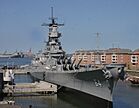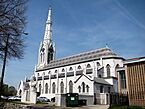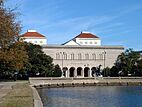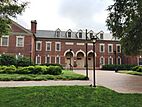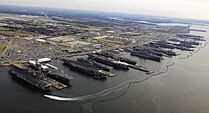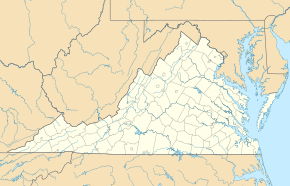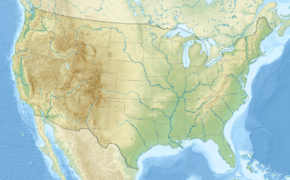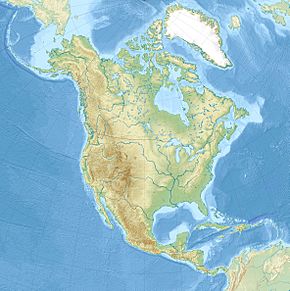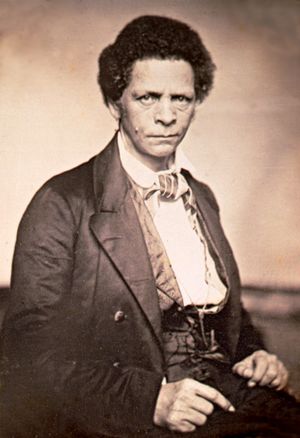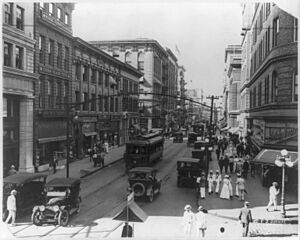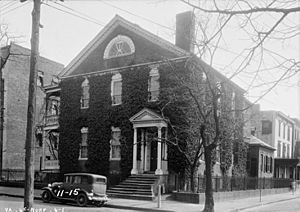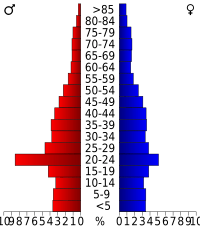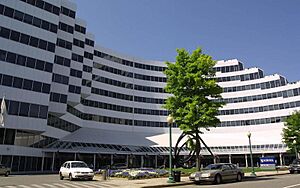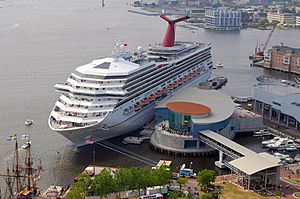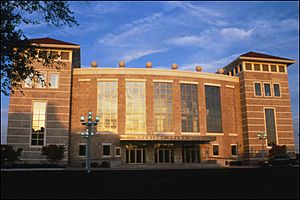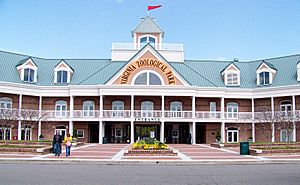Norfolk, Virginia facts for kids
Quick facts for kids
Norfolk
|
|||
|---|---|---|---|
|
Skyline of Downtown Norfolk
Naval Station Norfolk
|
|||
|
|||
| Motto(s):
Crescas (Latin for, "Thou shalt grow.")
|
|||
| Country | United States | ||
| State | Virginia | ||
| County | None (independent city) | ||
| Founded | 1680 (as town) | ||
| Incorporated | 1736 (as borough) | ||
| Incorporated | 1845 (as city) | ||
| Area | |||
| • Independent city | 96.40 sq mi (249.68 km2) | ||
| • Land | 53.27 sq mi (137.98 km2) | ||
| • Water | 43.13 sq mi (111.70 km2) | ||
| Elevation | 7 ft (2.1 m) | ||
| Population
(2020)
|
|||
| • Independent city | 238,005 | ||
| • Rank | 96th in the United States 3rd in Virginia |
||
| • Density | 4,468/sq mi (1,725/km2) | ||
| • Urban | 1,047,869 | ||
| • Metro | 1,725,246 (37th) | ||
| Time zone | UTC−5 (EST) | ||
| • Summer (DST) | UTC−4 (EDT) | ||
| ZIP Codes |
23501–23515, 23517–23521, 23523, 23529, 23541, 23551
|
||
| Area code(s) | 757, 948 | ||
| FIPS code | 51-57000 | ||
| GNIS feature ID | 1497051 | ||
| Primary Airport | Norfolk International Airport | ||
| Light Rail | The Tide | ||
| Public transportation | Hampton Roads Transit | ||
Norfolk (pronounced NOR-fuuk) is a city in Virginia, United States. It's called an independent city because it doesn't belong to any county. In 2020, about 238,000 people lived here. This makes it the third-largest city in Virginia.
Norfolk is a very important city in the Hampton Roads area. This area is also sometimes called "Tidewater." It's a big center for business, culture, and money. More than 1.8 million people live in the Hampton Roads region.
The city is surrounded by water. The Elizabeth River is to the west, and the Chesapeake Bay is to the north. Norfolk has many miles of waterfront, including beaches. This makes its coastal areas very important for the economy.
Norfolk is home to Naval Station Norfolk, which is the largest naval base in the world! It also hosts one of NATO's main headquarters. The city is a big part of the Port of Virginia. It's even home to Maersk Line, Limited, which manages the world's largest fleet of U.S.-flagged ships. Because it's so low-lying, Norfolk is at risk from sea level rise. Water levels could rise by more than 5.5 feet by the end of this century.
Norfolk has a long history as a key military and transportation spot. Many railroad lines started here. The city is connected to nearby areas by a huge network of highways, bridges, and tunnels. It even has three special bridge-tunnel complexes.
Contents
History of Norfolk
Early Days: Before 1607
Before 1607, the Chesepian people lived where Norfolk is now. Their villages were destroyed by the Powhatan tribe just before the Jamestown settlement began.
Colonial Times and the American Revolution
Settlers from the Virginia Colony started coming to this area early on. In 1619, a new government called the House of Burgesses was formed. The land that is now Norfolk became part of "Elizabeth Cittie."
In 1634, King Charles I changed the colony into "shires." Elizabeth Cittie became Elizabeth City Shire. A man named Adam Thoroughgood got a lot of land in 1636. He had convinced many people to settle in the colony.
When part of the shire was separated, Thoroughgood suggested naming it after his birthplace in England, Norfolk. So, it became New Norfolk County. Later, it split into Upper Norfolk and Lower Norfolk. This area became known for its business-minded people.
In 1680, the "Towne of Lower Norfolk County" was officially created. In 1691, Lower Norfolk County split again. It formed Norfolk County (which includes parts of today's Norfolk, Chesapeake, and Portsmouth) and Princess Anne County (now Virginia Beach).
Norfolk became an official town in 1705. It was a major port for sending goods to England. In 1736, King George II made it a royal borough.
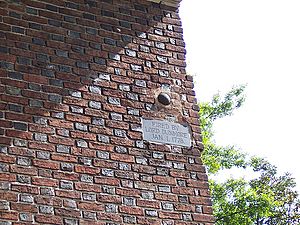
During the American Revolution, Norfolk had strong ties to the British Empire. But this wasn't enough to keep the British governor, Lord Dunmore, in power. On January 1, 1776, Lord Dunmore's ships attacked Norfolk. They shelled the city for over eight hours. The gunfire and fires started by the British, along with fires spread by the American Patriots, destroyed almost two-thirds of the city. Patriots then destroyed the rest for strategic reasons. Only the walls of Saint Paul's Episcopal Church survived. You can still see a cannonball from that attack stuck in its wall!
The 1800s: Rebuilding and Challenges
After the Revolutionary War, Norfolk worked hard to rebuild. In 1804, another big fire destroyed about 300 buildings. This caused a major setback for the city's economy. During the War of 1812, American soldiers fought against the British navy near Norfolk. On July 13, 1813, American militia, led by Richard Lawson, ambushed a British landing party. The Americans won, capturing prisoners and destroying a British boat.
In the 1820s, many farming communities in the South faced hard times. Many families moved west to places like Kentucky and Tennessee. This also happened because the soil was worn out from growing tobacco for many years.
The American Colonization Society suggested sending free Black people and freed slaves to Africa. They created a new colony called Liberia. However, most African Americans wanted to stay in the United States and gain their freedom and rights here. Some people from Virginia and North Carolina did leave from Norfolk's port to go to Liberia. Joseph Jenkins Roberts, a free Black man from Norfolk, later became the first president of Liberia.
On June 7, 1855, a ship arrived in Hampton Roads for repairs. It had come from the West Indies, where yellow fever was spreading. The ship was quarantined, but after 11 days, it was allowed to dock. A few days later, yellow fever cases appeared in Norfolk. By August, many people were dying each day. About a third of the city's population left to escape the disease. People didn't know how the disease spread. The epidemic spread through the city because of mosquitoes and poor sanitation. By September, about 3,200 people had died in Norfolk and Portsmouth. The city took a long time to recover.
In 1861, Virginia decided to leave the Union and join the Confederacy. In the spring of 1862, a famous naval battle happened near Norfolk. It was the Battle of Hampton Roads. This was the first time two ironclad ships, the USS Monitor and the CSS Virginia, fought each other. The battle was a tie, but it changed naval warfare forever. From then on, warships were built with metal armor.
In May 1862, Norfolk's mayor surrendered the city to Union forces. The Union controlled the city under martial law for the rest of the Civil War. Thousands of enslaved people from the area escaped to Union lines to become free. They quickly started schools in Norfolk to learn to read and write. This happened years before the war ended.
Norfolk in the 1900s and Today
In 1907, the Virginian Railway arrived in Norfolk. Also, the Jamestown Exposition was held at Sewell's Point. This big event showed how good the location was for a naval base. By 1917, as the U.S. got ready for World War I, the Naval Air Station Hampton Roads was built on the old exposition grounds. This laid the groundwork for what would become the world's largest naval base.
In the first half of the 1900s, Norfolk grew by adding nearby towns and areas. In 1906, it added Berkley. In 1923, it expanded to include Sewell's Point, Willoughby Spit, and Ocean View. This gave the city the Navy Base and miles of beaches. After a few more changes, Norfolk reached its current size.
After World War II, new highways were built. A series of bridges and tunnels connected Norfolk to nearby cities like the Peninsula, Portsmouth, and Virginia Beach. These connections helped people move around the region. They also led to new housing areas outside the city.
In 1954, the Supreme Court said that separate public schools for different races were illegal. Virginia, however, resisted this change. In 1958, courts ordered schools to integrate. The governor of Virginia then ordered the schools closed. But the Virginia Supreme Court said this was against the state's constitution. In February 1959, 17 Black children entered six previously segregated Norfolk public schools. This was a big step for integration.
Many middle-class white residents moved out of the city to the new suburbs. This caused Norfolk's population to decline. In the late 1960s and early 1970s, new shopping malls also hurt businesses in downtown Norfolk.
People for the Ethical Treatment of Animals (PETA), an animal rights group, has been based in Norfolk since 1996.
Norfolk's leaders started working to bring life back to its downtown area. They focused on the waterfront. Old piers and warehouses were torn down. A new road, Waterside Drive, was built. Many tall buildings now stand along it. In 1983, the city opened the Waterside festival marketplace to attract people back. The Waterside was updated in 2017. The waterfront also has the Nauticus maritime museum and the USS Wisconsin. Other attractions like the Harbor Park baseball stadium, home to the Norfolk Tides baseball team, also opened. Norfolk's efforts to improve its downtown have been praised across the country.
Norfolk's Geography

Norfolk is located in the southeastern part of Virginia. It sits where the Elizabeth River meets the Chesapeake Bay. The Hampton Roads area is the 37th largest in the United States. It includes cities like Norfolk, Virginia Beach, Chesapeake, and Newport News. Norfolk is seen as the main business center. Virginia Beach is known for its beaches and tourism.
Norfolk has many miles of waterfront property. This includes beaches in the Willoughby Spit and Ocean View areas.
Sea Level Rise and Norfolk
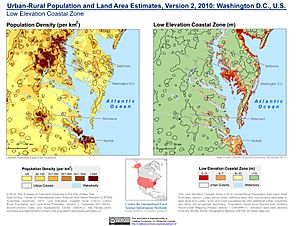
Norfolk is very low-lying and surrounded by water. This makes it especially vulnerable to rising sea levels. The land itself is also slowly sinking. Some areas already flood regularly during high tide. In 2012, a study estimated that dealing with a one-foot sea-level rise would cost about $1 billion. Scientists now believe the sea could rise by 5.5 feet or more by the end of this century.
City's Look: Architecture and Buildings
When Norfolk was first settled, homes were mostly made of wood. They had wide chimneys and thatched roofs. Later, the Georgian style became popular. Buildings were made of brick, often with special patterns. This style included features like large porches and two-story entrances. By 1740, Norfolk's streets were filled with homes, warehouses, and shops.
After the Revolutionary War, Norfolk was rebuilt in the Federal style. This style was inspired by Roman buildings. Federal homes kept the balanced look of Georgian homes but had more detailed decorations. They often had narrow windows next to the door and large porches. Few of these early homes are still standing.
In the early 1800s, Neoclassical elements appeared. These included ionic columns and classic designs over doors. Public buildings like the old City Hall used Greek and Roman styles.
Later, Gothic Revival became popular in the 1830s. This style featured pointed arches and steep roofs. Examples include the Freemason Baptist Church. In the 1840s, Italianate elements emerged, like small towers and decorative brickwork.
Tall buildings started to appear in the late 1800s. The Commodore Maury Hotel was one of the first. In the 1900s, Bungalows and apartment buildings became common. During the Great Depression, Art Deco became popular. The Post Office building downtown is an example. Art Deco buildings often have smooth surfaces and colorful tiles.
Norfolk's Neighborhoods
Norfolk has many historic neighborhoods, like Freemason. Some areas, such as Berkley, used to be separate towns. Others, like Willoughby Spit and Ocean View, have a long history with the Chesapeake Bay. In recent years, areas like Downtown, Ghent, and Fairmount Park have been revitalized. Popular places to live include Ghent, Colonial Place, and Lafayette Shores.
Norfolk's Climate
Norfolk has a humid subtropical climate. This means it has hot, humid summers and mild winters. Spring arrives in March with warm days. By late May, it feels like summer. Summers are consistently warm and humid. The nearby Atlantic Ocean helps keep daytime temperatures a bit cooler.
Temperatures reach 90°F or higher about 35 days a year. Temperatures of 100°F are rare. July is usually the warmest month. July and August are the wettest months due to thunderstorms. In August and September, there's more rain because of hurricanes and tropical storms. These storms usually just brush Norfolk, but sometimes they hit directly.
Fall brings mild to warm days and cooler nights. Winters are usually mild. Average winter days have lows near freezing and highs in the upper 40s to mid-50s (8 to 13°C). January is the coldest month. Snow doesn't happen often, with about 6.2 inches (16 cm) of snow each winter.
The hottest temperature ever recorded in Norfolk was 105°F (41°C) in 1918 and 2010. The coldest was -3°F (-19°C) in 1985.
| Climate data for Norfolk International Airport, Virginia (1981–2010 normals, extremes 1874–present ) | |||||||||||||
|---|---|---|---|---|---|---|---|---|---|---|---|---|---|
| Month | Jan | Feb | Mar | Apr | May | Jun | Jul | Aug | Sep | Oct | Nov | Dec | Year |
| Record high °F (°C) | 84 (29) |
82 (28) |
92 (33) |
97 (36) |
100 (38) |
102 (39) |
105 (41) |
105 (41) |
100 (38) |
95 (35) |
86 (30) |
82 (28) |
105 (41) |
| Mean maximum °F (°C) | 71.1 (21.7) |
73.2 (22.9) |
80.2 (26.8) |
86.4 (30.2) |
91.4 (33.0) |
95.5 (35.3) |
97.8 (36.6) |
95.8 (35.4) |
92.1 (33.4) |
85.6 (29.8) |
78.7 (25.9) |
72.5 (22.5) |
98.8 (37.1) |
| Mean daily maximum °F (°C) | 48.1 (8.9) |
50.9 (10.5) |
58.2 (14.6) |
67.6 (19.8) |
75.4 (24.1) |
83.5 (28.6) |
87.4 (30.8) |
85.1 (29.5) |
79.3 (26.3) |
70.1 (21.2) |
61.1 (16.2) |
52.1 (11.2) |
68.3 (20.2) |
| Mean daily minimum °F (°C) | 32.7 (0.4) |
34.4 (1.3) |
40.5 (4.7) |
48.9 (9.4) |
57.9 (14.4) |
67.1 (19.5) |
71.9 (22.2) |
70.7 (21.5) |
65.3 (18.5) |
54.0 (12.2) |
44.6 (7.0) |
36.1 (2.3) |
52.1 (11.2) |
| Mean minimum °F (°C) | 17.6 (−8.0) |
21.2 (−6.0) |
27.2 (−2.7) |
35.7 (2.1) |
45.7 (7.6) |
55.5 (13.1) |
63.1 (17.3) |
61.6 (16.4) |
53.7 (12.1) |
39.7 (4.3) |
30.5 (−0.8) |
21.7 (−5.7) |
15.2 (−9.3) |
| Record low °F (°C) | −3 (−19) |
2 (−17) |
14 (−10) |
23 (−5) |
36 (2) |
45 (7) |
54 (12) |
49 (9) |
40 (4) |
27 (−3) |
17 (−8) |
5 (−15) |
−3 (−19) |
| Average precipitation inches (mm) | 3.40 (86) |
3.12 (79) |
3.68 (93) |
3.41 (87) |
3.41 (87) |
4.26 (108) |
5.14 (131) |
5.52 (140) |
4.76 (121) |
3.42 (87) |
3.15 (80) |
3.26 (83) |
46.53 (1,182) |
| Average snowfall inches (cm) | 2.4 (6.1) |
2.0 (5.1) |
0.2 (0.51) |
trace | 0 (0) |
0 (0) |
0 (0) |
0 (0) |
0 (0) |
0 (0) |
trace | 1.2 (3.0) |
5.8 (15) |
| Average precipitation days (≥ 0.01 in) | 10.4 | 9.5 | 10.6 | 10.1 | 10.6 | 9.9 | 11.1 | 10.1 | 8.8 | 7.6 | 8.5 | 9.8 | 117.0 |
| Average snowy days (≥ 0.1 in) | 1.6 | 1.3 | 0.4 | 0.1 | 0 | 0 | 0 | 0 | 0 | 0 | 0 | 0.6 | 4.0 |
| Average relative humidity (%) | 66.3 | 65.6 | 64.6 | 62.8 | 68.8 | 70.6 | 73.3 | 75.2 | 74.4 | 72.1 | 68.5 | 67.0 | 69.1 |
| Mean monthly sunshine hours | 171.5 | 175.2 | 229.3 | 252.8 | 271.7 | 280.1 | 278.3 | 260.4 | 231.4 | 208.3 | 175.7 | 160.4 | 2,695.1 |
| Percent possible sunshine | 56 | 58 | 62 | 64 | 62 | 64 | 62 | 62 | 62 | 60 | 57 | 53 | 61 |
| Source: NOAA (relative humidity and sun 1961–1990) | |||||||||||||
Population and People
| Historical population | |||
|---|---|---|---|
| Census | Pop. | %± | |
| 1790 | 2,959 | — | |
| 1800 | 6,926 | 134.1% | |
| 1810 | 9,193 | 32.7% | |
| 1820 | 8,478 | −7.8% | |
| 1830 | 9,814 | 15.8% | |
| 1840 | 10,929 | 11.4% | |
| 1850 | 14,326 | 31.1% | |
| 1860 | 14,620 | 2.1% | |
| 1870 | 19,229 | 31.5% | |
| 1880 | 21,966 | 14.2% | |
| 1890 | 34,871 | 58.7% | |
| 1900 | 46,624 | 33.7% | |
| 1910 | 67,452 | 44.7% | |
| 1920 | 115,777 | 71.6% | |
| 1930 | 129,710 | 12.0% | |
| 1940 | 144,335 | 11.3% | |
| 1950 | 213,513 | 47.9% | |
| 1960 | 305,872 | 43.3% | |
| 1970 | 307,951 | 0.7% | |
| 1980 | 266,979 | −13.3% | |
| 1990 | 261,229 | −2.2% | |
| 2000 | 234,403 | −10.3% | |
| 2010 | 242,803 | 3.6% | |
| 2020 | 238,005 | −2.0% | |
| U.S. Decennial Census 1790–1960 1900–1990 1990–2000 [1] 2020 |
|||
Population in 2020
In 2020, Norfolk had a population of 238,005 people.
| Race / Ethnicity (NH = Non-Hispanic) | Pop 2000 | Pop 2010 | Pop 2020 | % 2000 | % 2010 | % 2020 |
|---|---|---|---|---|---|---|
| White alone (NH) | 110,221 | 107,463 | 97,205 | 47.02% | 44.26% | 40.84% |
| Black or African American alone (NH) | 102,268 | 102,452 | 93,553 | 43.63% | 42.20% | 39.31% |
| Native American or Alaska Native alone (NH) | 971 | 935 | 832 | 0.41% | 0.39% | 0.35% |
| Asian alone (NH) | 6,477 | 7,861 | 8,828 | 2.76% | 3.24% | 3.71% |
| Pacific Islander alone (NH) | 220 | 359 | 475 | 0.09% | 0.15% | 0.20% |
| Some Other Race alone (NH) | 483 | 471 | 1,331 | 0.21% | 0.19% | 0.56% |
| Mixed Race or Multi-Racial (NH) | 4,848 | 7,118 | 12,651 | 2.07% | 2.93% | 5.32% |
| Hispanic or Latino (any race) | 8,915 | 16,144 | 23,130 | 3.80% | 6.65% | 9.72% |
| Total | 234,403 | 242,803 | 238,005 | 100.00% | 100.00% | 100.00% |
Population in 2010
In 2010, Norfolk had 242,803 people living in 86,210 households. About 30% of households had children under 18. The average household size was 2.43 people.
About 24% of the population was under 18. About 18% were between 18 and 24. The median age was 30 years old. There were more males than females, especially for adults. This is because of the large military presence in the city.
The median income for a household was $31,815. About 19.4% of the population lived below the poverty line.
Different Ethnic Groups
In 2010, about 4,700 people of Filipino background lived in Norfolk. Chinese immigrants started coming after 1885. By 1995, about 300 Chinese families were part of the Chinese Community Association.
Norfolk's Economy
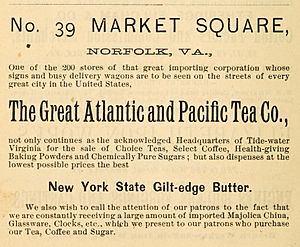
Norfolk is the business and cultural center of the Hampton Roads region. The many waterways around Hampton Roads are very important for the local economy. Norfolk's location at the mouth of the Chesapeake Bay makes it a major trade route. Goods are imported and exported from here to other parts of the U.S. and around the world.
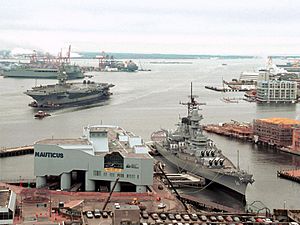
Hampton Roads is a big military center, especially for the United States Navy. Norfolk is home to Naval Station Norfolk, the world's largest naval base. This base is the headquarters for the United States Fleet Forces Command. It has over 62,000 active-duty personnel, 75 ships, and 132 aircraft. The base is also home to NATO's Allied Command Transformation headquarters.
The region is also important for defense contracts, especially in shipbuilding and ship repair. Major shipyards in Norfolk or the Hampton Roads area include BAE Systems Norfolk Ship Repair and Colonna's Shipyard Inc. The U.S. Navy's Norfolk Naval Shipyard is in Portsmouth, just across the river. Most of their work is for the Navy. More than 35% of the region's economy comes from defense spending.
After the military, the next biggest industry is the region's cargo ports. The Virginia Port Authority (VPA) is based in Norfolk. It owns and runs three major port facilities in Hampton Roads. Norfolk International Terminals (NIT) is one of these. It has some of the world's largest container cranes. These terminals handle millions of containers each year. This makes it the second busiest port on the East Coast of North America.
Norfolk also has the Lambert's Point docks. This is the largest coal shipping point in the Northern Hemisphere. It can handle about 48 million tons of coal each year. Coal from the Appalachian mountains is loaded onto trains and sent here. Then, it's loaded onto large ships and sent to other parts of the U.S., Europe, and Asia.
From 1925 to 2007, Ford Motor Company had a manufacturing plant in Norfolk. It produced Model-Ts, sedans, and F-150 pick-up trucks. Before it closed, the plant employed over 2,600 people.
Many major shipping companies have offices in Norfolk. Some of the largest international shipping companies have their North American headquarters here. These include CMA CGM, Zim Integrated Shipping Services, and Maersk Line Limited. Other major companies based in Norfolk include Norfolk Southern, Landmark Communications, and Portfolio Recovery Associates.
Tourism is also growing in Norfolk. The city built a cruise ship pier next to the Nauticus Museum downtown. This has brought more tourists to the city. The number of cruise ship passengers visiting Norfolk has grown a lot. In April 2007, a new $36 million cruise ship terminal was finished. This terminal is in downtown, close to hotels, restaurants, and shops.
Hampton Roads is home to four Fortune 500 companies. These are large companies that make a lot of money. They include Smithfield Foods, Norfolk Southern, Dollar Tree, and Huntington Ingalls Industries.
About 26% of the people who work in Norfolk also live in the city. The rest commute from other places.
Top Employers in Norfolk

Here are the top employers in Norfolk:
| # | Employer |
|---|---|
| 1 | U.S. Department of Defense |
| 2 | Sentara Healthcare |
| 3 | Norfolk City Public Schools |
| 4 | City of Norfolk |
| 5 | Old Dominion University |
| 6 | Children's Hospital of the King's Daughters |
| 7 | Eastern Virginia Medical School |
| 8 | Portfolio Recovery Associates |
| 9 | Anthem, Inc. |
| 10 | U.S. Navy Exchange |
Arts and Culture in Norfolk
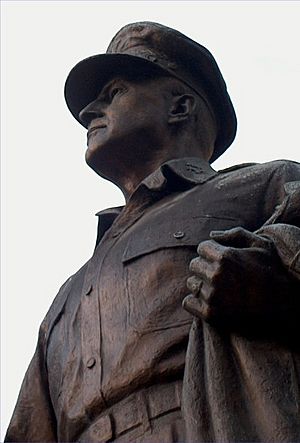
Norfolk is the cultural center of the Hampton Roads region. It has many museums and performing arts groups. The city also hosts several annual festivals and parades. Many of these take place in Town Point Park downtown.
Museums and Art Galleries
The Chrysler Museum of Art is a famous art museum. It's located where the Ghent district and Freemason neighborhood meet. The museum has grown many times since it opened in 1933. Today, it has over 50 galleries. It features American sculptures, a large glass collection, and a Glass Studio with live demonstrations.
The Chrysler Museum also manages the 1792 Moses Myers House Museum. This museum shows what life was like for Norfolk's first Jewish family in the early 1800s. Many of the items in the house belonged to the Myers family.
The Hermitage Foundation Museum is in a beautiful Tudor-style home. It's on a 12-acre estate along the Lafayette River. The Hermitage has a unique collection of Asian and Western art. It also offers art classes and special events. It's the only Smithsonian Affiliate in the Hampton Roads area.
Downtown Norfolk has other important museums.

Nauticus, the National Maritime Center, opened in 1994 on the downtown waterfront. It has hands-on exhibits, aquariums, and educational programs. Since 2000, Nauticus has been home to the battleship USS Wisconsin. This was the last battleship built in the United States. It served in World War II, the Korean War, and the Gulf War.
The MacArthur Memorial is in the old Norfolk courthouse. It holds the tombs of General Douglas MacArthur and his wife. It also has a museum, a large research library, and some of his personal items, like his famous corncob pipe.
Other special museums include the Hunter House Victorian Museum and the Norfolk Southern Museum.
Public Art Around the City
Norfolk is known for its "Mermaids on Parade" program. This started in 2002. Mermaid statues are placed all over the city. Visitors can take a walking tour downtown to find 17 mermaids. More can be found in other parts of the city.
The NEON district has many colorful murals. The City of Norfolk's Public Arts Commission supports many of these.
Performing Arts in Norfolk
Norfolk has many performing arts groups. The Virginia Symphony Orchestra, founded in 1920, is a leader in the arts. Most of their Norfolk performances are at Chrysler Hall. The orchestra also plays for other groups in the area.
The Virginia Stage Company, founded in 1968, is a top regional theater. They perform a full season of plays at the Wells Theatre downtown.
The Virginia Opera started in Norfolk in 1974. Their main performance hall is the Harrison Opera House in the Ghent district.
Large concerts are held at the Norfolk Scope arena or the Ted Constant Convocation Center at ODU. The Norva offers a smaller, more personal setting for concerts. Other cultural venues include the Attucks Theatre and the Naro Expanded Cinema.
Festivals and Celebrations
Norfolk hosts many arts and cultural festivals every year. The Virginia Arts Festival, started in 1997, brings artists from around the world. One of its key events is the Virginia International Tattoo. The Norfolk NATO Festival happens each spring. It celebrates Norfolk's role as NATO's North American Headquarters. It also promotes cultural exchange with NATO allies.
The Stockley Gardens Art Festival takes place twice a year in the Ghent neighborhood. It attracts artists and visitors from far away. The St. Patrick's Day parade in the Ocean View neighborhood celebrates its Irish heritage.
Harborfest is the region's largest annual festival. It's held in early June at Town Point Park. It celebrates the region's connection to the water. Highlights include a Parade of Sails with tall ships, music, food, and fireworks. The Bayou Boogaloo and Cajun Food Festival celebrates Cajun culture. It's a three-day festival in June with Cajun food and music.
Norfolk's Fourth of July celebration has a spectacular fireworks display. The Norfolk Jazz Festival attracts top jazz performers in August. The Town Point Virginia Wine Festival showcases wines made in Virginia. It's held in October, with a spring festival in May.
The revitalization of downtown Norfolk has improved the cultural scene. Many attractions are now connected by the 10.5-mile Elizabeth River Trail. This trail is for walking and biking along the waterfront. The lower Granby Street area now has many clubs and music venues. The Waterside Festival Marketplace is also a popular spot for nightlife.
Parks and Recreation
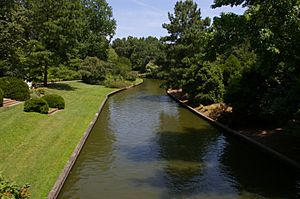
Norfolk has many parks and open spaces. The city has three beaches in the Ocean View area. Five other parks have picnic areas and playgrounds. The city also has community pools for residents. Town Point Park downtown hosts many annual events.
The Norfolk Botanical Garden, opened in 1939, is a 155-acre garden. It's located near the Norfolk International Airport and is open all year.
The Virginia Zoo, opened in 1900, is a 65-acre zoo. It has hundreds of animals, including the critically endangered Siberian tiger and threatened white rhino.
Sports in Norfolk
Norfolk is home to Virginia's two highest-level professional sports teams. The Norfolk Tides play baseball in the International League. The Norfolk Admirals play ice hockey in the ECHL.
Norfolk also has two universities with Division I sports teams. These are the Old Dominion Monarchs and the Norfolk State University Spartans. They offer sports like football, basketball, and baseball.
From 1970 to 1976, Norfolk was one of the home courts for the Virginia Squires professional basketball team. They played at the Old Dominion University Fieldhouse and later at the Norfolk Scope arena.
In 1971, Norfolk built the Norfolk Scope indoor arena, which seats 13,800 people. It has hosted major events, including the American Basketball Association All-Star Game in 1974. It also hosted the first two NCAA Women's Division I Basketball Championships in 1982 and 1983.
Norfolk is also home to the Norfolk Blues Rugby Football Club. They play at Lafayette Park. Virginia Beach City FC is a professional soccer club based in Norfolk. They play in the National Premier Soccer League at Powhatan Field.
Many wrestling shows have been held at Norfolk Arena and the Scope since the 1960s. These include events from the National Wrestling Alliance and World Wrestling Entertainment.
Education in Norfolk
Norfolk City Public Schools is the public school system. It has five high schools, eight middle schools, 34 elementary schools, and nine special-purpose schools. In 2005, Norfolk Public Schools won the $1 million Broad Prize for Urban Education. This award is for showing great improvement in student achievement.
There are also many private schools in the city. The oldest, Norfolk Academy, was founded in 1728. Religious schools include St. Pius X Catholic School and Norfolk Christian Schools. The city also hosts the Governor's School for the Arts.
Norfolk has three public universities and one private university. It also has a community college campus downtown. Old Dominion University started in 1930 and became independent in 1962. It offers many different degree programs. Eastern Virginia Medical School, founded in 1973, is known for its research in reproductive medicine. Norfolk State University, founded in 1935, is the second largest HBCU (Historically Black Colleges and Universities) in Virginia. It offers degrees in many subjects. Virginia Wesleyan College is a small private college. Tidewater Community College offers two-year degrees and training programs.
Norfolk Public Library
The Norfolk Public Library was Virginia's first public library. It has one main library, two anchor libraries, nine branch libraries, and a bookmobile. The library also has a special room for local history and family research. It offers computer classes, book reviews, and online book clubs.
The Slover Library, located downtown, has over 133,000 books. It hosts many classes and community events. It also has modern technology areas like a Sound Studio and Design Studio.
Media in Norfolk
Norfolk's daily newspaper is The Virginian-Pilot. Other local papers include the New Journal and Guide. Inside Business covers local business news.
Local universities also publish newspapers. These include Old Dominion University's Mace and Crown and Norfolk State University's The Spartan Echo.
Coastal Virginia Magazine is a magazine for Norfolk and the Hampton Roads area. Hampton Roads Times is an online magazine for the region.
Norfolk has many radio stations. They offer different types of music, news, and talk shows.
Norfolk is served by several television stations. The Hampton Roads area is the 42nd largest TV market in the U.S. Major network channels include CBS (WTKR), NBC (WAVY), and ABC (WVEC).
| Channel | Callsign | Network(s) | Website |
|---|---|---|---|
| 3 | WTKR | (CBS) | http://www.wtkr.com/ |
| 10 | WAVY | (NBC) | http://www.wavy.com |
| 13 | WVEC | (ABC) | http://www.wvec.com/ |
| 15 | WHRO | (PBS) | http://www.whro.org/ |
| 27 | WGNT | (Independent) | https://www.wtkr.com/wgnt |
| 33 | WTVZ | (MyNetworkTV) | http://www.mytvz.com |
| 43 | WVBT | (Fox, The CW [DT2]) |
http://www.fox43tv.com |
| 49 | WPXV-TV | (ION Television) | https://web.archive.org/web/20080215223141/http://www.ionline.tv// |
Norfolk residents can also get other independent stations. Cox Cable provides LNC 5, a local 24-hour news channel. DirecTV and Dish Network are also popular choices for TV.
Several movies have been filmed in and around Norfolk. These include Rollercoaster, Navy Seals, and Mission: Impossible III.
Norfolk's Infrastructure
Transportation in Norfolk
Norfolk has always been a key transportation hub. Many railroad lines started here. The city was once the main office for Norfolk Southern Railway, a major railroad company.
Norfolk is connected to nearby areas by a large network of highways, bridges, and tunnels. It has three unique bridge-tunnel complexes. Major roads include Interstate 64 and U.S. Route 58. The Hampton Roads Beltway (I-64 and I-664) circles Norfolk.
Norfolk is mainly served by the Norfolk International Airport (ORF). This is the region's main commercial airport. It offers nonstop flights to many destinations. Newport News/Williamsburg International Airport also provides flights for the Hampton Roads area.
Norfolk has Amtrak train service through the Norfolk station downtown. This line connects to Richmond and other cities.
Greyhound Lines provides bus service from a central terminal downtown.
In April 2007, the new $36 million Half Moone Cruise Terminal was finished downtown. It provides a modern place for cruise ships and passengers.
The Intracoastal Waterway passes through Norfolk. Norfolk also has many port facilities along the Elizabeth River.
Light rail, bus, ferry, and special transit services are provided by Hampton Roads Transit (HRT). HRT buses run throughout Norfolk and the Hampton Roads area. HRT's ferry service connects downtown Norfolk to Old Town Portsmouth.
The Tide light rail service started in August 2011. This light rail runs through the southern part of Norfolk. It connects areas like Norfolk State University and Harbor Park to downtown.
Utilities and Services
The city's Department of Utilities provides water and sewer services. Norfolk gets its electricity from Dominion Virginia Power. This power comes from local gas and coal plants, and the Surry Nuclear Power Plant. Virginia Natural Gas distributes natural gas to the city.
Norfolk's water quality is very good. It has been ranked as one of the cleanest water systems in the United States. The city has a large supply of fresh water from nine reservoirs. Water for Chesapeake and Virginia Beach is also pumped from Lake Gaston into Norfolk's reservoir system.
The city also handles wastewater services for residents. It sends wastewater to regional treatment plants.
Healthcare in Norfolk
Norfolk has a strong role in medicine. This is partly due to the Naval Medical Center Portsmouth and the Hampton VA Medical Center. Norfolk is served by Sentara Norfolk General Hospital, Sentara Leigh Hospital, and Bon Secours DePaul Medical Center. It's also home to the Children's Hospital of The King's Daughters.
Norfolk is home to Eastern Virginia Medical School (EVMS). EVMS is known for its specialists in diabetes, dermatology, and obstetrics.
The international headquarters of Operation Smile is in Norfolk. This group helps children around the world with facial deformities. Physicians for Peace, a non-profit that trains medical professionals in developing countries, is also based here.
Notable People from Norfolk
- Dennis Anderson, creator and driver of "Grave Digger"
- Ella Josephine Baker, civil rights activist
- Steve Bannon, former White House Chief Strategist
- Gary U.S. Bonds, rhythm & blues singer
- William Harvey Carney, soldier, Medal of Honor recipient
- Kam Chancellor, NFL safety for the Seattle Seahawks
- Clarence Clemons, saxophonist with Bruce Springsteen's E Street Band
- Michael Cuddyer, professional baseball player
- Rob Estes, actor
- Grant Gustin, actor, The Flash
- Elaine Luria, U.S. House of Representatives member
- William Magee, founder of Operation Smile
- Lenda Murray, professional bodybuilder
- Wayne Newton, singer and actor
- Joseph Jenkins Roberts, first president of Liberia
- Larry Sabato, political scientist
- Rhea Seehorn, actress, Better Call Saul
- Deborah Shelton, actress, Miss USA 1970
- John Wesley Shipp, actor, The Flash
- Bruce Smith, NFL defensive end, Pro Football Hall of Fame member
- Keely Smith, singer
- Timbaland, musician, hip-hop producer
- Justin Upton, MLB outfielder
- Melvin Upton, Jr, MLB outfielder
- Gene Vincent, Rock and Roll Hall of Fame member
- Pernell Whitaker, boxer, Olympic gold medalist
- Patrick Wilson, actor
- David Wright, MLB third baseman
Sister Cities
Norfolk has sister cities around the world. These partnerships help promote cultural exchange and understanding.
- Kitakyushu, Japan (since 1963)
- Wilhelmshaven, Germany (since 1976)
- Norfolk, England, United Kingdom (since 1986)
- Toulon, France (since 1989)
- Halifax, Nova Scotia, Canada (since 2006)
- Cagayan de Oro, Philippines (since 2008)
- Tema, Ghana (since 2010)
- Kochi, India (since 2010)
Wilhelmshaven is Germany's largest military harbor. Toulon is France's largest military harbor.
See also
 In Spanish: Norfolk (Virginia) para niños
In Spanish: Norfolk (Virginia) para niños



